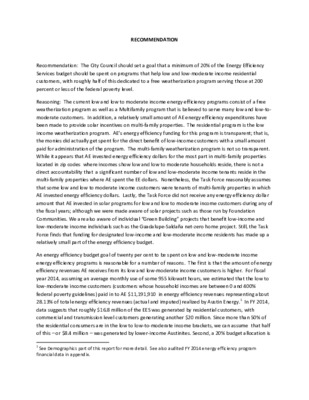Item 3a-Recommendation Regarding Energy Efficiency Budget Goal for Low and Low-Moderate Income Residential Customers_Cyrus Reed — original pdf
Backup

RECOMMENDATION Recommendation: The City Council should set a goal that a minimum of 20% of the Energy Efficiency Services budget should be spent on programs that help low and low-moderate income residential customers, with roughly half of this dedicated to a free weatherization program serving those at 200 percent or less of the federal poverty level. Reasoning: The current low and low to moderate income energy efficiency programs consist of a free weatherization program as well as a Multifamily program that is believed to serve many low and low-to-moderate customers. In addition, a relatively small amount of AE energy efficiency expenditures have been made to provide solar incentives on multi-family properties. The residential program is the low income weatherization program. AE’s energy efficiency funding for this program is transparent; that is, the monies did actually get spent for the direct benefit of low-income customers with a small amount paid for administration of the program. The multi-family weatherization program is not so transparent. While it appears that AE invested energy efficiency dollars for the most part in multi-family properties located in zip codes where incomes show low and low to moderate households reside, there is not a direct accountability that a significant number of low and low-moderate income tenants reside in the multi-family properties where AE spent the EE dollars. Nonetheless, the Task Force reasonably assumes that some low and low to moderate income customers were tenants of multi-family properties in which AE invested energy efficiency dollars. Lastly, the Task Force did not receive any energy efficiency dollar amount that AE invested in solar programs for low and low to moderate income customers during any of the fiscal years; although we were made aware of solar projects such as those run by Foundation Communities. We are also aware of individual “Green Building” projects that benefit low-income and low-moderate income individuals such as the Guadalupe-Saldaña net-zero home project. Still, the Task Force finds that funding for designated low-income and low-moderate income residents has made up a relatively small part of the energy efficiency budget. An energy efficiency budget goal of twenty per cent to be spent on low and low-moderate income energy efficiency programs is reasonable for a number of reasons. The first is that the amount of energy efficiency revenues AE receives from its low and low-moderate income customers is higher. For fiscal year 2014, assuming an average monthly use of some 955 kilowatt hours, we estimated that the low to low-moderate income customers (customers whose household incomes are between 0 and 400% federal poverty guidelines) paid in to AE $11,191,910 in energy efficiency revenues representing about 28.13% of total energy efficiency revenues (actual and imputed) realized by Austin Energy.1 In FY 2014, data suggests that roughly $16.8 million of the EES was generated by residential customers, with commercial and transmission level customers generating another $20 million. Since more than 50% of the residential consumers are in the low to low-to-moderate income brackets, we can assume that half of this – or $8.4 million – was generated by lower-income Austinites. Second, a 20% budget allocation is 1 See Demographics part of this report for more detail. See also audited FY 2014 energy efficiency program financial data in appendix. consistent with the spending goal for only low income customers that the City of San Antonio has for its public utility. Specifically the Task Force is recommending the following dollar amounts for the current low and low to moderate income energy efficiency programs based on a $42 million budget (the amount AE estimates it will recover in FY 2016). Low income weatherization program--$4.2 million. We believe that assuming the current spending of roughly $4,000 per home would weatherize at least 1000 homes. We also encourage Austin Energy to spend at least part of this amount on a recommended pilot “voucher” or “rebate” approach. We recognize that part of the funding for the weatherization program may be augmented through the CAP allocation or be supplemented by federal funds or grants as available. As economies of scale and new types of programs hopefully lower the amount spent per home, we believe that for a budget of roughly $5 million, Austin Energy might be able to weatherize 2,000 homes or units. Emergency Medically Vulnerable Funding – Austin Energy should set aside a portion of the above funding or create another pot of money to serve those truly in need for emergency AC window units. We believe a budget of $200,000 should be sufficient. Multi-family -- $4.0 million, of which approximately half –$2.0 million – should be dedicated to buildings in which at least half of the tenants would qualify as low or low-to-moderate income residents. Solar –$1.0 million should be dedicated to Multifamily properties that serve lower-income individuals, or to subsidize community solar rates to allow more low-income people to participate in community solar. With a current budget of roughly $7.4 million, setting aside $1 million to serve residents or buildings that house lower-income residents is reasonable. The remaining $1 million of the $8.4 million representing 20% of AE’s estimated revenues to be realized should be spent on new pilot programs – including potentially creating a loan-loss account for financing measures – on augmenting existing programs such as the Greenbuilding program to focus more on affordable housing and on current programs where some low-moderate income customers (specifically the customers whose household incomes are at 300 to 400% federal poverty guidelines) may be participating.